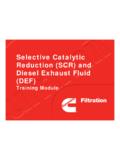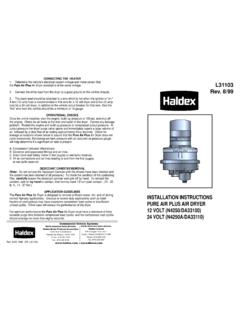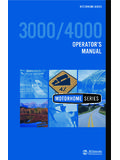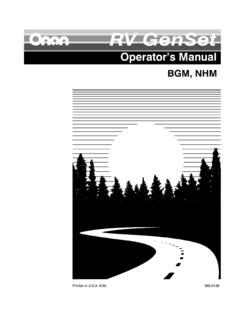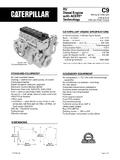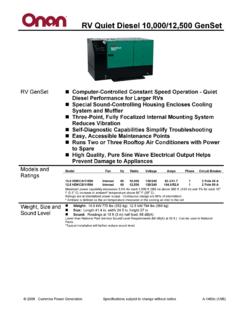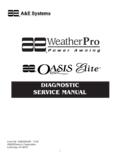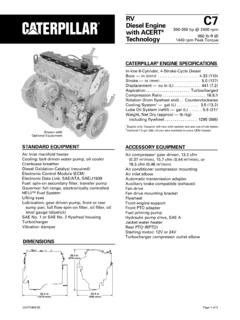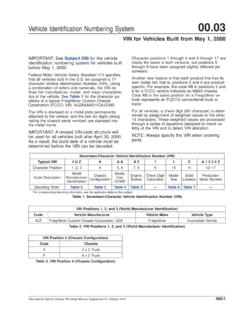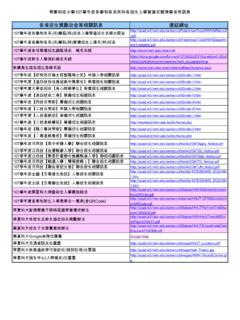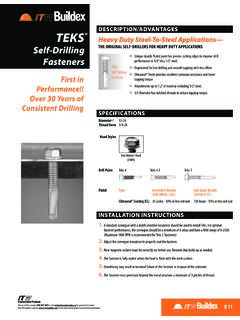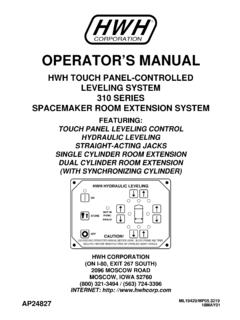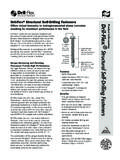Transcription of Hydraulics and HWH Systems - RV Tech Library
1 1 FLOWPRESSUREHYDRAULICS AND HWH Systems 1. PREFACE This is a discussion of basic Hydraulics which can help with the diagnostics and repair of HWH hydraulic leveling and room extension Systems . The first section of this school, INTRODUCTION TO Hydraulics is a more in-depth study of general Hydraulics and should be studied before continuing in this section. ADAPTATION OF Hydraulics will repeat or review topics that were discussed in INTRODUCTION TO Hydraulics but is directed more at the way HWH adapts Hydraulics to our leveling and room extension Systems . Although a complete understanding of Hydraulics is important, there are several principles which can ease the diagnostics of most hydraulic problems in a HWH hydraulic leveling or room extension system .
2 It is also important to understand how the different components in the Systems work. This will all be discussed in this study along with the value of using schematics to understand and diagnose hydraulic Systems . 2. hydraulic PRINCIPLES 2-1 First, liquids are practically incompressible. Example: If you have a glass jar filled to the top with a liquid, you will not be able to put a stopper in the jar. If you force the stopper in, the jar will shatter. Figure 1 What this means in a HWH hydraulic system is if the pump is running, the fluid has to go somewhere.
3 If the system is functioning properly, a jack should be extending or a room extension should be extending or retracting. If nothing is moving with the pump running, the system pressure should rise to the point where the fluid will flow across a relief valve back to the pump reservoir. Simply put, if a hydraulic cylinder is moving, the fluid in the system is moving OR to make a hydraulic cylinder move, the fluid in the system has to move. 2-2 Second, fluids transmit pressure in all directions. Pressure in fluid has no one specific direction. The flow of fluid is directional. The direction fluid flows in a system can be changed by opening or closing valves but pressure in the system just is.
4 In the drawing below, the piston is pushing the fluid out of the cylinder. The direction of flow is to the hole in the end of the cylinder but the pressure in the cylinder is the same at the piston and on the walls of the cylinder as it is at the hole in the end of the cylinder. Figure 2 2 70 180 30 1 quart1 quart1 quart9,000 POUNDSPOUNDS12,0003,000 Third, fluid can provide a great increase in work force. This is the main reason HWH has chosen to use hydraulic Systems instead of electric motors, electric actuators, pulley and gear Systems , etc. The formula used to calculate force is: F (force) = P (pressure) x A (area).
5 Force is figured in pounds, pressure is figured in psi (pounds per square inch) and area is the square inches of the movable rod or piston in the cylinder. Area can be any shape but for this study we are dealing with circles. The area of a circle is p(r2). The value of p is and r is the radius of a circle or the diameter of the circle. Example: The rod in a 9,000# capacity jack has a diameter of 2 inches. The radius of that rod is 1 inch. The area of the rod is (p) x (1x1) (r2) = Although most of the pumps HWH uses have a relief set at 3,500 psi, the working pressure HWH uses when figuring jack capacity is 3,000 psi.
6 3,000 (pressure) x (area) = 9,420# (force) or 9,000 pounds of lifting capacity. I guess we could call it a 9420 pound jack but instead we round the figure down. The capacity of a leveling jack or room mechanism is essential knowledge when figuring the correct jack or mechanism needed to lift and level a coach or move a room. Figure 3 2-4 Fourth, is the effect change in temperature can have on fluid. Note that water reacts differently than oil. When the temperature of a fluid is increased (gets hotter), the volume of the fluid increases. As the temperature decreases (cools), the volume of the fluid decreases.
7 This is called thermal expansion or contraction . If you take a jar filled with fluid at room temperature and place it over a burner, the fluid will flow over the side of the jar as the temperature of the fluid increases. If you take a jar filled with fluid at room temperature and put it in the freezer, the level of the fluid will drop as the fluid cools. The same thing happens in our hydraulic Systems . The thermal expansion and contraction can make the leveling jacks extend or retract slightly and to a lesser extent cause some issues in room extension Systems . Figure 4 Remember, if the temperature of the fluid in a system increases, the volume of the fluid in that system increases.
8 That extra fluid has to go somewhere! If the temperature decreases, the volume of fluid decreases. That would be the same as the fluid moving. It is possible that a cylinder may move. 3 "160 "500 POUNDS1,500 PUMP480 "POUNDS5001, "2,500 "POUNDS9,000 PUMP3,500 "9,000 POUNDS3. HOW Hydraulics WORKS 3-1 Pressure and flow are the key ingredients to a hydraulic system . Pressure, along with the size of the cylinders dictates the force the system has available to use. This was explained in the third principal. The amount of fluid the pump can move dictates how fast a cylinder will move. This is measured in GPM or gallons per minute.
9 It should be noted at this time that all a hydraulic pump does is move the fluid through the system . Pumps will only create pressure if there is resistance to the moving fluid. So in a given system , the more pressure the system will produce, the more force the cylinders can create. The more fluid the pump moves, GPM, the quicker the cylinders can move. Figure 5 3-2 Fluid will always take the path of least resistance. If two cylinders of equal size are connected to a single supply line, they will produce the same force. If one of the cylinders is trying to lift 500 pounds and the other cylinder is trying to lift 1500 pounds, fluid will flow to the cylinder that is lifting 500 pounds while the other cylinder does not move.
10 The system will only produce enough pressure to lift the lighter weight. Pressure in the system will not increase until the resistance to the flow increases, in this case when the first cylinder is fully extended. When the first cylinder is fully extended, the pressure will start to increase and the second cylinder can now lift the 1500 pounds as long as the system can develop adequate pressure and there is plenty of fluid in the reservoir. Figure 6 3-3 One of the hardest issues to overcome when designing and building a hydraulic system is trying to make two cylinders move at the same speed.
